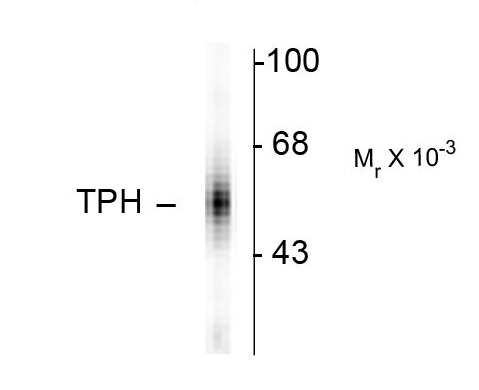Tryptophan Hydroxylase Antibody
Affinity purified sheep polyclonal antibody
- SPECIFICATION
- CITATIONS
- PROTOCOLS
- BACKGROUND

Application
| WB |
|---|---|
| Primary Accession | P17290 |
| Reactivity | Human, Rat |
| Host | Sheep |
| Clonality | polyclonal |
| Calculated MW | 55 KDa |
| Gene ID | 100101558 |
|---|---|
| Gene Name | TPH1 |
| Other Names | Tryptophan 5-hydroxylase 1, Tryptophan 5-monooxygenase 1, TPH1, TPH |
| Target/Specificity | Recombinant rabbit tryptophan hydroxylase, isolated as inclusion bodies from E. coli and purified by preparative SDS-PAGE. |
| Dilution | WB~~ 1:1000 |
| Format | Prepared from sheep serum by affinity purification using a column to which the recombinant protein was coupled. |
| Antibody Specificity | Specific for the ~55k tryptophan hydroxylase protein. |
| Storage | Maintain refrigerated at 2-8°C for up to 6 months. For long term storage store at -20°C in small aliquots to prevent freeze-thaw cycles. |
| Precautions | Tryptophan Hydroxylase Antibody is for research use only and not for use in diagnostic or therapeutic procedures. |
| Shipping | Blue Ice |

Thousands of laboratories across the world have published research that depended on the performance of antibodies from Abcepta to advance their research. Check out links to articles that cite our products in major peer-reviewed journals, organized by research category.
info@abcepta.com, and receive a free "I Love Antibodies" mug.
Provided below are standard protocols that you may find useful for product applications.
Background
Tryptophan hydroxylase (TPH) catalyzes the first step in the biosynthesis of serotonin and melatonin (Martinez et al., 2001). Thus, expression of TPH can be used as an indicator of the localization of serotonin and melatonin in brain. In mammals, serotonin biosynthesis occurs predominantly in neurons which originate in the Raphe nuclei of the brain, and melatonin synthesis takes place within the pineal gland (Haycock et al., 2002) . Although TPH catalyzes the same reaction within the Raphe nuclei and the pineal gland, TPH activity is rate-limiting for serotonin but not melatonin biosynthesis (Martinez et al., 2001).
References
Haycock JW, Kumer SC, Lewis DA, Vrana KE, Stockmeier CA (2002) A monoclonal antibody to tryptophan
hydroxylase: applications and identification of the epitope. J Neurosci Methods 114:205-212.
Martinez A, Knappskog PM, Haavik J (2001) A structural approach into human tryptophan hydroxylase and its
implications for the regulation of serotonin biosynthesis. Curr Med Chem 8:1077-1091.
If you have used an Abcepta product and would like to share how it has performed, please click on the "Submit Review" button and provide the requested information. Our staff will examine and post your review and contact you if needed.
If you have any additional inquiries please email technical services at tech@abcepta.com.













 Foundational characteristics of cancer include proliferation, angiogenesis, migration, evasion of apoptosis, and cellular immortality. Find key markers for these cellular processes and antibodies to detect them.
Foundational characteristics of cancer include proliferation, angiogenesis, migration, evasion of apoptosis, and cellular immortality. Find key markers for these cellular processes and antibodies to detect them. The SUMOplot™ Analysis Program predicts and scores sumoylation sites in your protein. SUMOylation is a post-translational modification involved in various cellular processes, such as nuclear-cytosolic transport, transcriptional regulation, apoptosis, protein stability, response to stress, and progression through the cell cycle.
The SUMOplot™ Analysis Program predicts and scores sumoylation sites in your protein. SUMOylation is a post-translational modification involved in various cellular processes, such as nuclear-cytosolic transport, transcriptional regulation, apoptosis, protein stability, response to stress, and progression through the cell cycle. The Autophagy Receptor Motif Plotter predicts and scores autophagy receptor binding sites in your protein. Identifying proteins connected to this pathway is critical to understanding the role of autophagy in physiological as well as pathological processes such as development, differentiation, neurodegenerative diseases, stress, infection, and cancer.
The Autophagy Receptor Motif Plotter predicts and scores autophagy receptor binding sites in your protein. Identifying proteins connected to this pathway is critical to understanding the role of autophagy in physiological as well as pathological processes such as development, differentiation, neurodegenerative diseases, stress, infection, and cancer.


